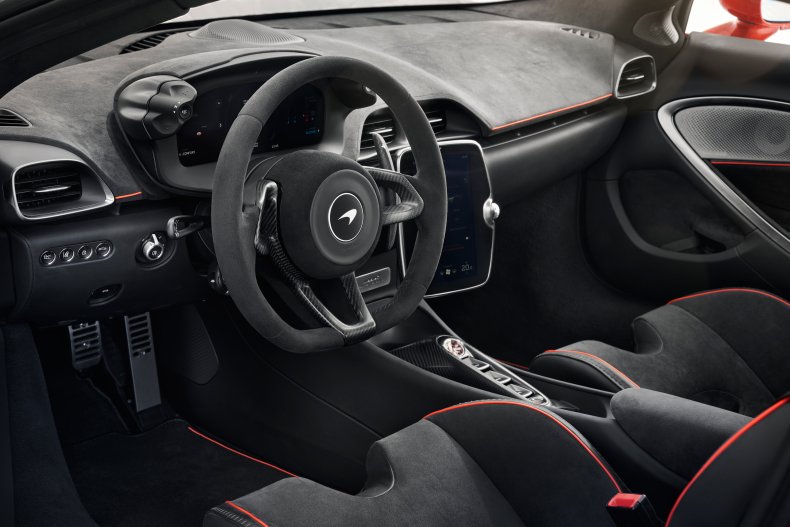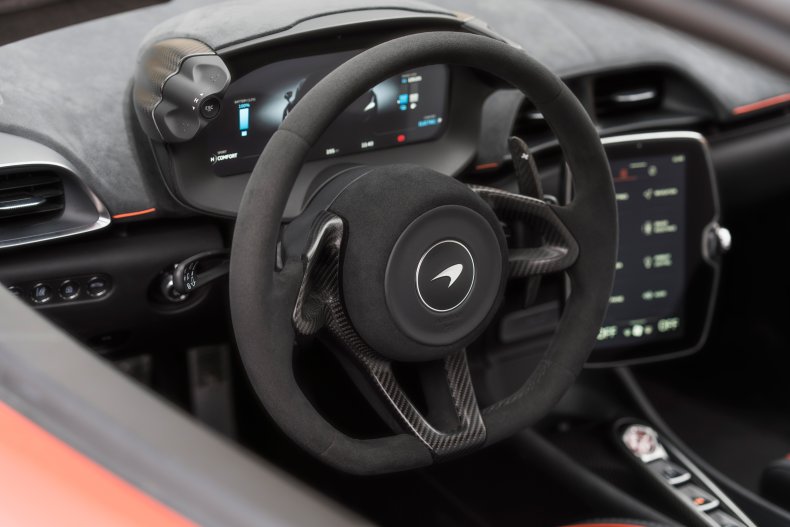In the supercar realm there are the legends like Ferrari and Lamborghini, who started this whole six-figure supercar arms race in the 1940s and '60s. There are the newcomers like Pagani and EV maker Rimac.
And then there's McLaren, a company with as much racing experience as any automaker, but is only now entering its second decade as a production car company (an excellent early effort with the McLaren F1 notwithstanding). Like those legends, McLaren is beginning to think about sustainability, starting with the plug-in hybrid 2023 McLaren Artura.
"We've delivered more than 10,000 units to customers over the last 10 years and the Americas market now makes up over 40 percent of global sales. We've really been fortunate enough to cultivate this very passionate but very enthusiastic group of owners and really the thread that connects all of them is their love and passion for driving," McLaren President of Americas Nicolas Brown told Newsweek.
"And we see that in the mileage that they put on their cars. If you're looking at the competitive set, McLaren owners definitely drive their cars more than the competition."

The new McLaren Artura matches up nicely, powertrain-wise with the competition from Maserati and Ferrari (and the outgoing hybrid Acura NSX). The Artura's new twin-turbo 3.0-liter V6 engine is a hybrid, attached to an electric motor and 7.4-kWh battery that together make 671 horsepower (hp).
The new Ferrari 296 GTB also has a twin-turbo 3.0-liter V6 with an electric motor and plug. The Prancing Horse delivers a whopping 818 hp. However, the Ferrari has a base price of $322,986 while the Artura comes in almost $100,000 cheaper at $233,000.
The Maserati MC20, a named competitor of the Artura, too has a twin-turbo V6, though not a hybrid. Its Nettuno engine delivers 621 hp and that package costs $212,000.
All three have multiclutch transmissions with paddle shifters and an automatic mode.
This year has been a big one for McLaren. The company is continuing its investment in the American market, opening a new 35,000-square-foot headquarters in Dallas to service all the press, marketing and track cars. It also has its customization department there, for well-heeled customers that can't make it to UK homebase in Woking. From its Dallas Fort Worth (DFW) International Airport-adjacent location, McLaren's team can get to every area of the Americas region in about three hours.
"We like to think of it as the embarkation of the second decade in the story of McLaren Automotive as a series production manufacturer that started in 2011. It is in fact more than simply the launch of a new car because the Artura introduces a number of new technologies," Jamie Corstorphine, director of product strategy, McLaren Automotive told Newsweek.

"Chief amongst that is a new architecture built from a clean sheet design. A new architecture, one that's been absolutely optimized for high performance hybrid powertrains. And that's an architecture that will underpin a whole range of McLaren models going into the future," he said.
The focus of the new McLaren Carbon Lightweight Architecture (MCLA) was weight savings in every area, including the electrical systems, which brought the Artura to a curb weight of just 3,303 pounds. The total weight of hybrid components including the battery pack and electric motor is 287 pounds of that.
The Artura is rear-wheel drive with an electronic limited-slip differential, automatically sending power to the wheel with the most grip. From a standstill, it accelerates to 60 miles per hour (mph) in 3 seconds, 124 mph in 8.3 seconds and has a top speed of 205 mph.
The McLaren Artura can plug into a Level 2 EV charger, the one that works off a 220-volt outlet, and can get fully charged in 2.5 hours. It has an all electric range of 11 miles, and can go more than 80 mph in that silent mode. The battery can also be saved for later in certain driving modes.

McLaren kept the steering wheel free of controls, in opposition to Ferrari, which puts them all on the wheel. However, behind the wheel are the usual stalks for turn signals and wipers, but no radio controls. Buttons for nose lift, lane keeping, (which was added along with adaptive cruise control and over-the-air updates with the new electrical architecture), door locks and frunk opening are to the left of the wheel.
The digital instrument cluster is attached to the plain wheel along with the paddle shifters. That cluster moves with the steering wheel adjustment so important information is always visible. The gear selector buttons are centered between the seats.
Becuase of its new electronics, the Artura is the first McLaren to offer advanced driver assistance systems (ADAS). They include Intelligent Adaptive Cruise Control with Stop/Go, Road-Sign Recognition, and Lane-Departure Warning.
The Artura is on sale now.
2023 McLaren Artura Review
What is it like driving the Artura? Predictable in all the right ways. On the winding and undulating desert roads outside of Las Vegas the McLaren Artura is comfortable with a new adaptive suspension. The McLaren 720S, which debuted in 2017, was astonishingly compliant on midwestern roads in Comfort mode when tested. The Artura is the same, though it uses a more traditional adaptive suspension than its predecessor, absorbing the dry, lightly broken pavement leading to the Valley of Fire.
Once the blacktop gets relatively smooth, the Handling toggle can be flipped to Sport mode, quickening the accelerator and the shifts, making them almost seamless even nearing the 8,200 rpm redline. Rear visibility is excellent with a clear view above the mid-rear-mounted engine behind the driver. After a few miles heatwaves coming off the engine blur the view when sitting still.

Grip is astonishing on the road, but even better on the flat road course at Las Vegas Motor Speedway with Pirelli P-Zero Corsa high-performance summer tires. The stock option are standard Pirelli P-Zero tires, with 19-inch wheels in front and 20-inch wheels in back.
The nine-turn track is about a mile long and features a few sweeping turns along with some sharper zigzags. The rear end only gave way twice, both times just slightly and with the traction control on, but with the Artura in track mode. The first time was around a sweeper at 70 or so miles per hour and was easy to bring back, the second happened when lifting off the throttle quickly around a corner at slightly slower speed, which sends all of the weight of the vehicle forward, and is never advised.
In two, seven-lap sessions the standard carbon ceramic brakes never faded, staying confident stopping from 130-mph-plus speeds down the front straight. The steering feel is perfect from an electro-hydraulic system with tons of feedback from the wide front tires.
With the new engine, McLaren was given a chance to create a new sound at wide-open throttle, and it succeeded in besting its previous V8 engine by a long shot, though the Artura still isn't as sonorous as its Ferrari and Maserati counterparts.

Like the previous McLarens, the Artura has separate driving modes for both the powertrain and handling. Comfort, Sport and Track are available in both. Electric powertrain mode will keep the engine off. It will also use its stop/start function to turn off the engine when stopped.
Inside there are two options for seats. One is a powered "comfort" setup, and McLaren moved the adjustment controls to the outside of the seats from the inside where it was much more difficult to find and use. The second is called the Clubsport seat. That seat keeps its bucket shape, but slides and pivots to different driving positions. Both are comfortable, but for enthusiasts the no-charge Clubsport seats are better.
The Artura comes with a new 8-inch touchscreen with Apple CarPlay. It's oriented in a portrait layout with a volume knob/home button on the side. The screen features a metal bezel, and the volume dial looks like a winder, making the whole thing feel like a big watch face.
In practice, the Apple CarPlay icons are small and hard to find while driving. The native system works better on the screen, though it's still less convenient than the phone interface. The climate controls are pinned at the bottom of the screen and are always available.
Most buyers that could afford to spend $233,000 on a McLaren could alternately afford a Ferrari or Lamborghini. However, the Artura offers something different, in its character, name and history.
If they do choose the McLaren, they get the "if you know, you know" reaction from enthusiasts, meaning far fewer will gawk than if they were driving a Ferrari, but the gawking will be much more passionate. To some, that may be worth more than 100 or so extra horsepower.
"pure" - Google News
December 13, 2022 at 09:45PM
https://ift.tt/AXTQJgy
2023 McLaren Artura Review: Stealthy Silence Meets Pure Power - Newsweek
"pure" - Google News
https://ift.tt/AxUin1l
https://ift.tt/69PhYOD
Bagikan Berita Ini














0 Response to "2023 McLaren Artura Review: Stealthy Silence Meets Pure Power - Newsweek"
Post a Comment